Distributed Transactions
Mit «distributed transactions» gibt der Masterstudiengang Transdisziplinarität Einblicke in Diplomprojekte und Arbeitsprozesse seiner Studierenden. Ein zweites Jahr schon nähern sich in diesem Ausstellungskonzept Analoges und Digitales. In diesem hybriden Format werden Werke in einer Ausstellung gezeigt und gleichzeitig auf einer eigens dafür konzipierten Website erfahrbar gemacht. Besucher*innen können immer wieder Studierenden vor Ort begegnen und haben die Möglichkeit, Live-Instagram Channels beizuwohnen oder performative Arbeiten in unterschiedlichen Satelliten zu besuchen.
With «distributed transactions», the Master's programme Transdisciplinarity provides insights into the diploma projects and work processes of its students. For a second year already, the analogue and the digital are coming closer together in this exhibition concept. In this hybrid exhibition format, works are in an exhibitionspace and at the same time made tangible on a specially designed website. Visitors can meet students in the exhibition, attend live Instagram channels or visit performative works in different satellite.
01
How can you participate
in calligraphy?
«Xianqi Dai (Valerie) can not do calligraphy»
戴纤蕲不会书法
Xianqi Dai (Valerie)
It is an experimental piece of interdisciplinary mixed media that incorporates Hip Hop music and Chinese calligraphy. (Music produced by Kahoo Yang, a beat maker from China)
With long studying of Chinese calligraphy, Dai has generated her own understanding and style of writing. However, she also gets confused by some questions from time to time.
She wants to ask, argue, and answer her own questions by means of a planned experiment. Instead of contemplating, she wants to listen to the audience.
It is a work to challenge herself as well as the audience.
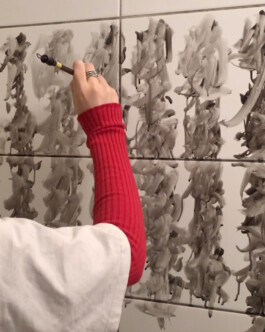
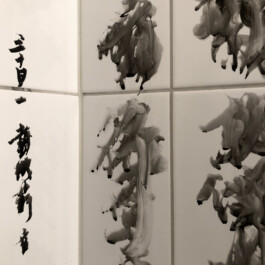
Xianqi Dai was born in Guiyang, Guizhou, and live in Switzerland. She received a BA (Honors) degree and a MA (First class honor) in Visual Arts at Academy of Visual Arts, HKBU. She is currently studying for her second Master’s degree in Interdisciplinary Studies at the University of the Arts, Zurich.
She has been studying Chinese calligraphy for more than fifteen years. She enjoys using ink as the media to create artworks related to traditional art and she is susceptible to the emotional fluctuations of living beings. She regards her artwork as a realistic embodiment of emotion. Her artworks advocate that people should pay attention to the basic qualities of themselves and that the audience should respect the innermost feelings of others.
02
What stories appear
through re-reading
ancient myths?
«Sortir-au-Jour (W.I.P.)»
Emmanuel Michaud
«Sortir-au-Jour» gathers elements of research for a film project. It takes as its starting point the funerary traditions of ancient Egypt – the Osirian myth, the Book of the Dead and other rites. Those stories are looked at through the lens of the second law of thermodynamics: the law of entropy. The travel of the deceased to the Underworld is considered as another symptom of the tendency of all things to merge, to lose structure and organisation; within the liminal space of funerary rites, confusion is created, and the differences between humans and divinities blur.
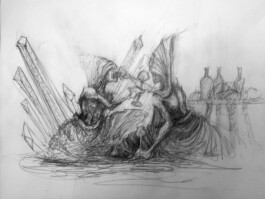
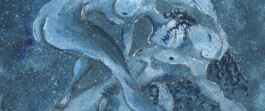
03
What’s between
writing a poem
and trimming a bonsai?
«A bottle of wine among the flowers»
Jiaxi Han
Because of my nostalgia for ancient Chinese poetry, I began to recall the poems I had read in the past, and I started to translate and transform them.
During this time, I also wrote my own poems. My writing and translation of ancient poems started to intertwine. As a summary of this journey, a selection of the texts which I worked on will be gathered and displayed in a bonsai garden.
Emmanuel Michaud (born 1997) is a French transdisciplinary artist, navigating between performance, stage design, dance, video, text, music & sound design. Through his fictions, he opens tensions and reveal mutual influences between staged spaces, characters and their bodies. He is one of the founding members of the collective SIBJA, active since 2016.
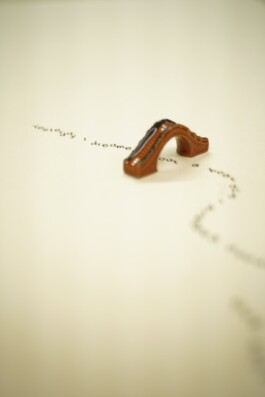
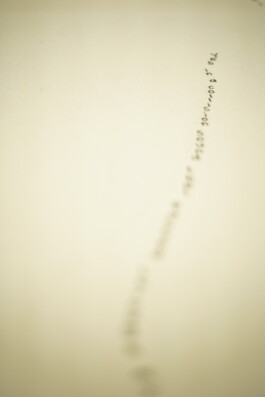
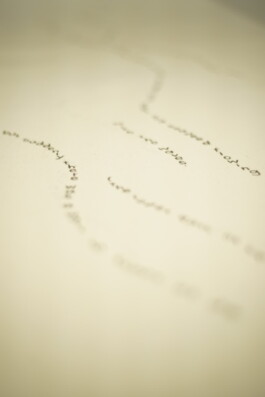
Jiaxi Han (China, 1993), graduated from Hong Kong Baptist University with a Bachelor and Master degree in Visual Arts. She works around the traditional batik craft of her hometown Guizhou and writes poetry.
04
Thinking
through traces?
«BLOB»
Chiara Alissa Estivariz Lopez
Between thread and breathe she blobs out of the atmosphere.
Shifting patterns, shifting space the blob extends the place.
Zoom in, zoom out, textile its about.
Breathing in, breathing out, the choreography comes around.
So blob the poop out to get it all about?
Where to got from now?
Let’s see her blob style blowing like it’s always flowing.
Coming to an end is all she pretends.
BLOB is a performative attempt to encounter the slime mould and its memory.
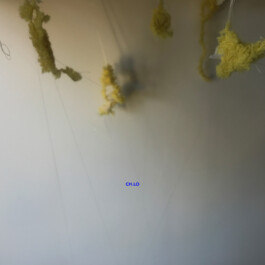
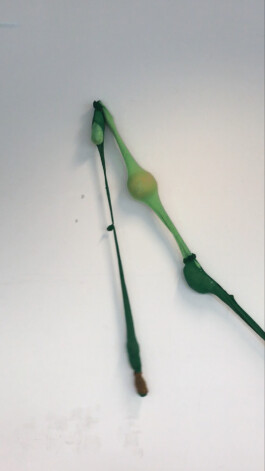
05
Did we prove
anything and if so,
what was it?
«Künstlerische Praxis»
Njomza Dragusha, Alexandre Gaeng, Judith Hessler, Klara Mand
We meet every week. We spent our first months discussing and finding a common language, as we four speak three different languages and come from different disciplines. We have gathered a collection of perspectives, understandings and have therefore a lot of content to discuss and share. Somehow the space of Künstlerische Praxis is always where we are and how we are, don’t you think?
Chiara Alissa Estivariz Lopez is a Design graduate from the University of Pforzheim. Her field of work consists mainly of textile, graphics, architecture and its interaction with human beings and objects. Her current work is about the blob. In this research, she explores performative textile knowledge interwoven with film and photographs.

We are a collective created in early 2020. Njomza Dragusha worked as community organizer in various collective projects inside and out of the artistic settings. Her practice derives from the need to build spaces (meta and physical) for social use. She is searching for ways to translate and embody community politics through artistic practices. Alexandre Gaeng explores frictions and audiences expectations by shaping cultural events with immersive overarching dramaturgy. Interested in collaborative practices within and beyond sonic and visual arts, they also work as curator and art director. Klara Mand is a stage and costume designer, shaping the term of theatre as a place for encounter, exchange and discussion, using performativity as a tool of experiment and making collective processes part of the work itself. After years of classical cultural reception and intellectual formation in art history, philosophy & German studies, Judith Heßler lost her closeness to the “real world” and, driven by the question of a responsible continuum of action, set out in search of boundaries and interstices of theory and practice. Three is a family, four is a gang.
06
Imagining the
unimaginable – possible?
«Weight of Time»
Maya Lama
Exploring Time in Space
spring summer autumn winter
sun moon stars rain
sometimes time tics, sometimes time tocs
time ticks, time talks,
hiccups, falls,
rains like snow
in space it waits,
for none, its' weight?
some?
summer autumn winter spring
stars rain sun moon

07
Do you have
access to
your history?
«In Absence Of (Experience Creol), 2021»
Nicolas Walker, Yara Dulac Gisler, Modulaw
Transnational adoptions are shaped by cultural, economic, legal and social conditions. The audio installation piece «In Absence Of (Experience Creol), 2021» shows how this practice, which has existed since the 20th century, can affect bodies and what resistance strategies these bodies find – far beyond the fringes of colonial narratives.
The texts, written by Nicolas Walker and spoken by Yara Dulac Gisler, are understood as lyrics inserted into the sounds of Modulaw.
Maya Lama choses to spend time with her art practice investigating questions of choices and decision making regarding – what see? how see? what do? what say? what play? combining micro-macro stories of relations with the world of surfaces, textures, rules, atoms, stars, boys over 18, roommates, etc.
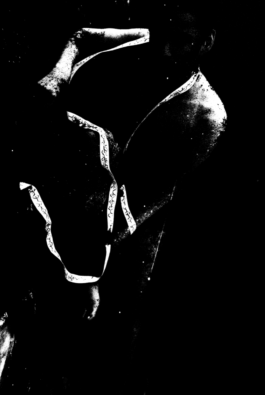
Nicolas Walker (*Brazil, 1992), a body that came to speak
08
How can
a normative practice
be questioned?
«LETTERS to bias and Formalisations»
Fernando Obieta
An investigation into normative practices, the delegation of morality into, and how the arts can reflect upon them, through the formalisation of text-messaging. A series of four artworks «to clock», ,«to direct», «to lave», and «to face” – LETTERS; a different terminology to always see abstractions and the ‹solutions› it produces as situated – Formalisations; and an interrogation of my own position – bias.
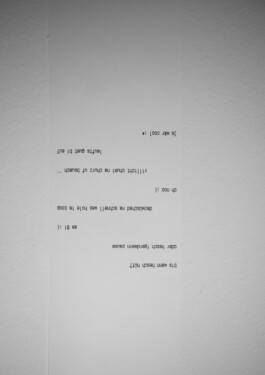
09
Getting lost
in the space of
each other?
«Black Box Fading»
Melody Chua
Black box fading reflects my experience developing and working with a musical improvisation machine, and it can be seen as a transient imagination of this machine’s memories and dreams. The sonic and visual material present in this event have been derived from improvisations I made with the machine between December 2020 and March 2021. Between performance and installation, and between physical and virtual spaces, the material plays between shifting perceptions of human-machine agency, interaction, and (dis)embodiment. Getting lost in the space of each other becomes the game of representation, and there is no better way to describe this than through actions rather than words. So welcome to this black box. It is a pleasure having you here.
Fernando Obieta is a new-media artist, interaction designer, and programmer and studied Interaction Design and Media Technology. His artistic work and research focus on the critique and reflection of (digital) media, artefacts, systems, services, and solutions — which he refers to as formalisations.
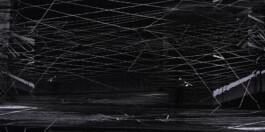
Melody Chua (b. 1994) creates immersive futuristic fictions, oftentimes with undertones of nostalgia and introspection, pulling audiences into intimate worlds. To carry her artistic narratives, she eagerly explores new technologies, including 360° touchscreens, 360° videos, Ambisonics, motion capture systems, live-coding, pressure-sensitive shoes, real-time projection visuals, and sensor-augmented instruments, while at the same time reflecting critically on the multifaceted issues surrounding human-machine interactions.
10
How can
environmental listening
inspire
ecological change?
«Soundwalking, listening to the hum»
Mélia Roger
We never give attention to the hum. It's always around, constant, unconscious. We only spot it once it stops. During this soundwalk, we will focus on the unheard sounds, the smallest constant flow around us. From air conditionning ventilation to blowing wind or water flow, we will try to explore our sonic relation to the hum soundscape.

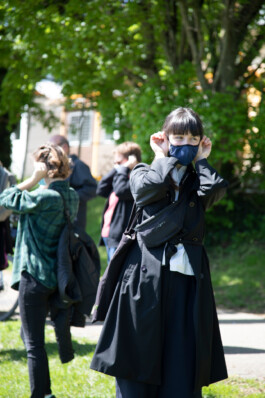
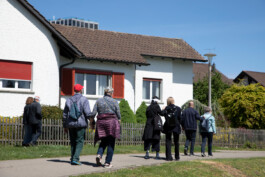

11
Is it
made in China
or made
in Switzerland?
«Red, Blue, and Family Letters»
Jiaxi Han
Inspired by the history that in the 19th century, agents selling fabrics in other countries communicated with textile companies in Switzerland, mainly through letters sent back and forth many times to get the right designs and sales, I wrote to my parents in my hometown, attaching Glarner Tuechli as sample, and asked the craftswomen there to produce these fabrics accordingly and send them to me in Switzerland. Every time i sent fabrics in Turkish red, I received an imitated one in indigo blue.
Text
Mélia Roger is a sound designer for film and art installation. She has a classical music background and owns a Master Degree in sound engineering (ENS Louis-Lumière, Paris, France). She spent her last year of Master in the Transdisciplinary Studies Program at ZHdK (Zurich University of the Arts, Switzerland), where she developed an artistic approach of sound, working with voice and field recordings. She is now living between Paris and Zurich, working for post-production film and her own artistic works.
meliaroger.com
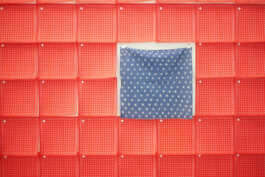
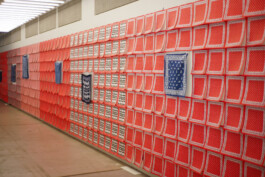
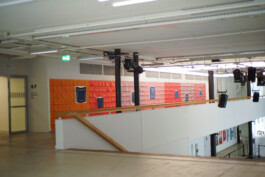
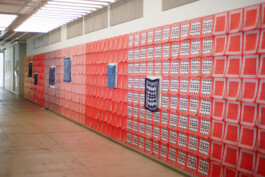
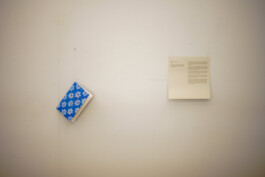
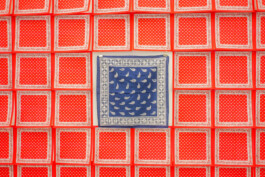
Jiaxi Han (China, 1993), graduated from Hong Kong Baptist University with a Bachelor and Master degree in Visual Arts. She works around the traditional batik craft of her hometown Guizhou and writes poetry.
Distributed Transactions
Mit «distributed transactions» gibt der Masterstudiengang Transdisziplinarität Einblicke in Diplomprojekte und Arbeitsprozesse seiner Studierenden. Ein zweites Jahr schon nähern sich in diesem Ausstellungskonzept Analoges und Digitales. In diesem hybriden Format werden Werke in einer Ausstellung gezeigt und gleichzeitig auf einer eigens dafür konzipierten Website erfahrbar gemacht. Besucher*innen können immer wieder Studierenden vor Ort begegnen und haben die Möglichkeit, Live-Instagram Channels beizuwohnen oder performative Arbeiten in unterschiedlichen Satelliten zu besuchen.
With «distributed transactions», the Master's programme Transdisciplinarity provides insights into the diploma projects and work processes of its students. For a second year already, the analogue and the digital are coming closer together in this exhibition concept. In this hybrid exhibition format, works are in an exhibitionspace and at the same time made tangible on a specially designed website. Visitors can meet students in the exhibition, attend live Instagram channels or visit performative works in different satellite.
01
How can you participate
in calligraphy?
«Xianqi Dai (Valerie) can not do calligraphy»
戴纤蕲不会书法
Xianqi Dai (Valerie)
It is an experimental piece of interdisciplinary mixed media that incorporates Hip Hop music and Chinese calligraphy. (Music produced by Kahoo Yang, a beat maker from China)
With long studying of Chinese calligraphy, Dai has generated her own understanding and style of writing. However, she also gets confused by some questions from time to time.
She wants to ask, argue, and answer her own questions by means of a planned experiment. Instead of contemplating, she wants to listen to the audience.
It is a work to challenge herself as well as the audience.


Xianqi Dai was born in Guiyang, Guizhou, and live in Switzerland. She received a BA (Honors) degree and a MA (First class honor) in Visual Arts at Academy of Visual Arts, HKBU. She is currently studying for her second Master’s degree in Interdisciplinary Studies at the University of the Arts, Zurich.
She has been studying Chinese calligraphy for more than fifteen years. She enjoys using ink as the media to create artworks related to traditional art and she is susceptible to the emotional fluctuations of living beings. She regards her artwork as a realistic embodiment of emotion. Her artworks advocate that people should pay attention to the basic qualities of themselves and that the audience should respect the innermost feelings of others.
02
What stories appear
through re-reading
ancient myths?
«Sortir-au-Jour (W.I.P.)»
Emmanuel Michaud
«Sortir-au-Jour» gathers elements of research for a film project. It takes as its starting point the funerary traditions of ancient Egypt – the Osirian myth, the Book of the Dead and other rites. Those stories are looked at through the lens of the second law of thermodynamics: the law of entropy. The travel of the deceased to the Underworld is considered as another symptom of the tendency of all things to merge, to lose structure and organisation; within the liminal space of funerary rites, confusion is created, and the differences between humans and divinities blur.


Emmanuel Michaud (born 1997) is a French transdisciplinary artist, navigating between performance, stage design, dance, video, text, music & sound design. Through his fictions, he opens tensions and reveal mutual influences between staged spaces, characters and their bodies. He is one of the founding members of the collective SIBJA, active since 2016.
03
What’s between
writing a poem
and trimming a bonsai?
«A bottle of wine among the flowers»
Jiaxi Han
Because of my nostalgia for ancient Chinese poetry, I began to recall the poems I had read in the past, and I started to translate and transform them.
During this time, I also wrote my own poems. My writing and translation of ancient poems started to intertwine. As a summary of this journey, a selection of the texts which I worked on will be gathered and displayed in a bonsai garden.



Jiaxi Han (China, 1993), graduated from Hong Kong Baptist University with a Bachelor and Master degree in Visual Arts. She works around the traditional batik craft of her hometown Guizhou and writes poetry.
04
Thinking
through traces?
«BLOB»
Chiara Alissa Estivariz Lopez
Between thread and breathe she blobs out of the atmosphere.
Shifting patterns, shifting space the blob extends the place.
Zoom in, zoom out, textile its about.
Breathing in, breathing out, the choreography comes around.
So blob the poop out to get it all about?
Where to got from now?
Let’s see her blob style blowing like it’s always flowing.
Coming to an end is all she pretends.
BLOB is a performative attempt to encounter the slime mould and its memory.


Chiara Alissa Estivariz Lopez is a Design graduate from the University of Pforzheim. Her field of work consists mainly of textile, graphics, architecture and its interaction with human beings and objects. Her current work is about the blob. In this research, she explores performative textile knowledge interwoven with film and photographs.
05
Did we prove
anything and if so,
what was it?
«Künstlerische Praxis»
Njomza Dragusha, Alexandre Gaeng, Judith Hessler, Klara Mand
We meet every week. We spent our first months discussing and finding a common language, as we four speak three different languages and come from different disciplines. We have gathered a collection of perspectives, understandings and have therefore a lot of content to discuss and share. Somehow the space of Künstlerische Praxis is always where we are and how we are, don’t you think?

We are a collective created in early 2020. Njomza Dragusha worked as community organizer in various collective projects inside and out of the artistic settings. Her practice derives from the need to build spaces (meta and physical) for social use. She is searching for ways to translate and embody community politics through artistic practices. Alexandre Gaeng explores frictions and audiences expectations by shaping cultural events with immersive overarching dramaturgy. Interested in collaborative practices within and beyond sonic and visual arts, they also work as curator and art director. Klara Mand is a stage and costume designer, shaping the term of theatre as a place for encounter, exchange and discussion, using performativity as a tool of experiment and making collective processes part of the work itself. After years of classical cultural reception and intellectual formation in art history, philosophy & German studies, Judith Heßler lost her closeness to the “real world” and, driven by the question of a responsible continuum of action, set out in search of boundaries and interstices of theory and practice. Three is a family, four is a gang.
06
Imagining the
unimaginable – possible?
«Weight of Time»
Maya Lama
Exploring Time in Space
spring summer autumn winter
sun moon stars rain
sometimes time tics, sometimes time tocs
time ticks, time talks,
hiccups, falls,
rains like snow
in space it waits,
for none, its' weight?
some?
summer autumn winter spring
stars rain sun moon

Maya Lama choses to spend time with her art practice investigating questions of choices and decision making regarding – what see? how see? what do? what say? what play? combining micro-macro stories of relations with the world of surfaces, textures, rules, atoms, stars, boys over 18, roommates, etc.
07
Do you have
access to
your history?
«In Absence Of (Experience Creol), 2021»
Nicolas Walker, Yara Dulac Gisler, Modulaw
Transnational adoptions are shaped by cultural, economic, legal and social conditions. The audio installation piece «In Absence Of (Experience Creol), 2021» shows how this practice, which has existed since the 20th century, can affect bodies and what resistance strategies these bodies find – far beyond the fringes of colonial narratives.
The texts, written by Nicolas Walker and spoken by Yara Dulac Gisler, are understood as lyrics inserted into the sounds of Modulaw.

Nicolas Walker (*Brazil, 1992), a body that came to speak
08
How can
a normative practice
be questioned?
«LETTERS to bias and Formalisations»
Fernando Obieta
An investigation into normative practices, the delegation of morality into, and how the arts can reflect upon them, through the formalisation of text-messaging. A series of four artworks «to clock», ,«to direct», «to lave», and «to face” – LETTERS; a different terminology to always see abstractions and the ‹solutions› it produces as situated – Formalisations; and an interrogation of my own position – bias.

Fernando Obieta is a new-media artist, interaction designer, and programmer and studied Interaction Design and Media Technology. His artistic work and research focus on the critique and reflection of (digital) media, artefacts, systems, services, and solutions — which he refers to as formalisations.
09
Getting lost
in the space of
each other?
«Black Box Fading»
Melody Chua
Black box fading reflects my experience developing and working with a musical improvisation machine, and it can be seen as a transient imagination of this machine’s memories and dreams. The sonic and visual material present in this event have been derived from improvisations I made with the machine between December 2020 and March 2021. Between performance and installation, and between physical and virtual spaces, the material plays between shifting perceptions of human-machine agency, interaction, and (dis)embodiment. Getting lost in the space of each other becomes the game of representation, and there is no better way to describe this than through actions rather than words. So welcome to this black box. It is a pleasure having you here.

Melody Chua (b. 1994) creates immersive futuristic fictions, oftentimes with undertones of nostalgia and introspection, pulling audiences into intimate worlds. To carry her artistic narratives, she eagerly explores new technologies, including 360° touchscreens, 360° videos, Ambisonics, motion capture systems, live-coding, pressure-sensitive shoes, real-time projection visuals, and sensor-augmented instruments, while at the same time reflecting critically on the multifaceted issues surrounding human-machine interactions.
10
How can
environmental listening
inspire
ecological change?
«Soundwalking, listening to the hum»
Mélia Roger
We never give attention to the hum. It's always around, constant, unconscious. We only spot it once it stops. During this soundwalk, we will focus on the unheard sounds, the smallest constant flow around us. From air conditionning ventilation to blowing wind or water flow, we will try to explore our sonic relation to the hum soundscape.




Mélia Roger is a sound designer for film and art installation. She has a classical music background and owns a Master Degree in sound engineering (ENS Louis-Lumière, Paris, France). She spent her last year of Master in the Transdisciplinary Studies Program at ZHdK (Zurich University of the Arts, Switzerland), where she developed an artistic approach of sound, working with voice and field recordings. She is now living between Paris and Zurich, working for post-production film and her own artistic works.
meliaroger.com
11
Is it
made in China
or made
in Switzerland?
«Red, Blue, and Family Letters»
Jiaxi Han
Inspired by the history that in the 19th century, agents selling fabrics in other countries communicated with textile companies in Switzerland, mainly through letters sent back and forth many times to get the right designs and sales, I wrote to my parents in my hometown, attaching Glarner Tuechli as sample, and asked the craftswomen there to produce these fabrics accordingly and send them to me in Switzerland. Every time i sent fabrics in Turkish red, I received an imitated one in indigo blue.
Text






Jiaxi Han (China, 1993), graduated from Hong Kong Baptist University with a Bachelor and Master degree in Visual Arts. She works around the traditional batik craft of her hometown Guizhou and writes poetry.